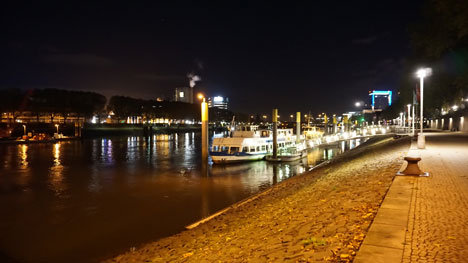
When our bus rolled into the cobbled city centre of Bremen in northern Germany, dusk had already descended on river Weser. The drizzle and the chill wintry fog didn't augur well for our short stay in the port city.
An illustrious member of the Hanseatic league (a commercial guild of 190 north Germanic cities of the late 1100s meant to dominate Baltic maritime trade), Bremen is a gem hidden deep inside Deutschland. But given our choc-a-bloc tour itinerary, I wasn't sure I'd get to see any of its sparkle.
By the time we finished dinner - pasta with grilled king prawns, green asparagus and fresh basil in white wine-butter sauce - the drizzle had turned into a downpour. And that is why when instead of wishing us goodnight, our guide Friedrich Von Maltzahn asked if anyone was interested in a walk to the heart of the city, it was a complete surprise. Only five of us raised our hands, but Maltzahn was game.
We were walking along the rain-soaked promenade, where sleepy tourist launches lay tied to the jetty, when we spotted giant rats squeaking past. "The legendary city of Hamelin is only about 200 kilometres upstream," remarked Maltzahn. It seems the Grimm brothers' Pied Piper of Hamelin is a reference to the rat plagues of medieval Germany. It is a reminder of the mass migration of the knackered townsfolk to East Europe and beyond.
Deutsche Märchenstraße or the German Fairy Tale Route runs south to north - from Hanau near Frankfurt, birthplace of Wilhelm and Jacob Grimm, to Bremen. Over 600 kilometres long, the route meanders through villages, towns and cities that featured in the life of the Grimms. It also incorporates forests, castles and towers that were the setting for some of the best-known tales.

The rain lashed hard as we passed Schlachte, Bremen's original harbour for over 600 years, to step into Böttcherstraße. Böttchers or utensil makers made and repaired casks and barrels here until the 19th century. Today, the alley is an open-air art gallery.
At the start of the 20th century, Ludwig Roselius, a local coffee merchant and inventor of decaffeinated coffee, bought all the abandoned houses on this dilapidated street. He had them rebuilt and adorned with artwork and sculptures. One of them, built in 1588, is now the Roselius Museum showcasing his art collection.
Apparently nearly 60 per cent of Böttcherstraße had to be restored after being bombed during the two World Wars. Bremen's most famous street led us to the Town Hall, the only European town hall of the late Middle Ages that was never destroyed. Close to this stands a huge Roland statue, a knight with a drawn sword. "This is one of the oldest. These were once positioned at marketplaces in central Europe as a symbol of freedom and market rights," says Maltzahn.

While we watched the Town Hall and its intricate sculptures in sandstone, the sharp sound of raindrops falling on the gravel was broken by the flutter of a tramcar - with a lone passenger in it. Bremers call their city "a village with a tram line". As the tram disappeared towards the St. Petri Dom Cathedral, we walked towards the iconic monument depicting The Town Musicians of Bremen - a bronze sculpture of a donkey, a dog, a cat and a rooster, which glistened in the rain and soft light. We solemnly rubbed the hooves of the donkey for good luck.
We were meant to see Schnoor, the fishing quarter dating back to the 15th century, but the rain came in the way. We also missed the Spuckstein, a spitting stone marking the spot where Gesche Gottfried was beheaded in 1831. Gesche, who had murdered 15 people, was the last person to be publicly executed. Tourists spit on the stone to express their disgust.

Day 2 was so bright and sunny that the previous night may well have been a dream. We visited the hi-tech space centre, EADS Astrium, home to Airbus planes and modules for the International Space Station, and research labs of the University of Bremen and Jacobs University, where robots and remote-operated vehicles are built to explore deep oceans as well as the moon surface.
And thus, from the medieval world of fairy tales and beheadings, hop, skip and jumping those unpleasant centuries ridden with war and destruction, we journeyed to the future, just like that - all in the splendid little big city of Bremen.











